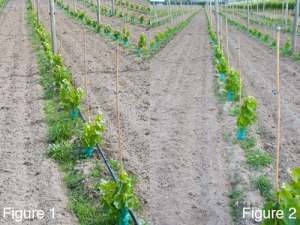There are some serious considerations to be taken into account, prior to the planting if you wish to be successful, as Jonathan Hamlet, Villa Maria’s Hawke’s Bay regional viticulturist told the recent Organic and Biodynamic Winegrowing conference.
“We want to grow, craft and sell exciting wines that express our unique terroir,” he said. “The vineyard is very much the foundation for this goal.”
It all starts at the very beginning, when the site, varietal mix, rootstock and initial management practices are chosen.
Hamlet who is also the chair of Organic Winegrowers NZ, said there are a number of challenges to overcome, in the initial stages, to ensure the sustainable longevity of the vineyard.
Weeds, root structure, rootstock and planting density are just some of those challenges.
Hamlet says a lot of the rootstock used in New Zealand has riparia parentage, and in the late 90s and early 2000s, the focus was on reducing the vine’s vigour.
“With an organic system that is not necessarily applicable,” he said. “I think we need to re-evaluate our rootstock choice very closely.”
Growers want enough vigour from the vine, to cope with the conditions they will face without the need for more water and nutrients. To achieve that, the root system needs to be large and robust. Root structure is an area Villa Maria’s viticulturists have been focusing on according to Hamlet. The aim is to have a robust root system that is driving down into the sub soils, rather than clinging to the top and relying on irrigation.
“Be it organic or non-organic, we run under vine cultivation aiming around pre and post root flush, so in the autumn and the spring, to take out surface roots, to drive them away.
“A shallow root system follows the irrigation drip line. They have no intention of exploring the inter row and they do not express terroir.”
Hamlet also wondered if the standard grafting of rootstock and scion is actually the best to encourage that root growth.
“This year we actually grafted 500 rootstock making them 150 mm longer. I want to be able to plant them deeper, so they go further into that soil moisture and aren’t as reliant on irrigation.”
Theories around planting density have changed over the years, with the accepted norm now being to plant for what you want to produce. Just don’t over estimate that. But if you are wanting to remove vine stress, and increase longevity, look closely at density, Hamlet said.
“If you have a higher vine density, there is less stress on the vine through less crop load. Less stress means better vineyard longevity. But be aware that it does have implications on undervine operations.”
While Villa Maria hand planted some of their new developments, Hamlet says he prefers machine planting, mainly due to the horrors of J-rooting he has seen in the past.
“Machine planting gives us good consistency, timing and it is obviously efficient. But one thing we do do a lot, is use the biodynamic calendar for our planting. I want our plants in the early phases of establishment to be focused on root growth.”
Weeds not only compete with the young vines for water and nutrients, they also are costly to deal with. So why not deal with it at the first opportunity possible? Drip irrigation feeds the surface of the soil, and is a lifeline to all the emerging weeds. However sub surface drip lines ensure the top few centimeters of soil where the weeds reside is not being fed the elixir of life. Villa Maria have installed sub surface drip lines in vineyards in both Marlborough and Hawke’s Bay, after being shown research that the system means 20 to 30 percent less water was required to feed the young vines. (See Figures 1 and 2, that show the difference in weed growth between sub surface and drip line irrigation.) The added bonus, it also reduces maintenance costs, especially after sheep have been let loose among the vines over the winter months.
On a new development of two hectares, Hamlet says they weren’t confident enough to place the sub surface irrigation in initially, given the soil had no water holding capacity.
“We were worried it was such a shallow root system, that putting the drip line below it wouldn’t be enough to sustain the new vine growth. So we installed normal surface drip lines, expect for two rows where we put in sub surface irrigation.”
At the end of harvest the vines were compared – and there was no difference in growth between the two systems.
“We had almost identical cane length, so there were no negatives.” Now the entire development has sub surface irrigation.
So while there are no silver bullets to ensure young vines go on to be healthy, well aging adults, there are a number of scenarios growers can consider, when starting anew.












